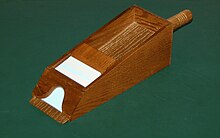Red Dog (card game)
Red Dog , also Acey Deucey or in between , is a card - gambling that in casinos is offered.
Red Dog originated in the USA around 1900 ; the origin of the name is unknown, possibly Red Dog was the name of a saloon in which this game was cultivated. In addition, the name " Red Dog " also stands for the high card pool game of chance ; the name " Acey Deucey " is just as ambiguous, Acey Deucey is also called a backgammon variant.
The following explanation describes the casino game.
Rules of the game
General
Red Dog is played with six packs of 52 French playing cards ; these are shuffled by the croupier , couped (i.e. lifted ) by a player and placed in a card slot by the croupier.
Before each coup who make Pointeure their bets (Engl. Bets ), then the dealer draws two cards, which he openly presents on the table, but he leaves a distance, so possibly a third card can be placed in the center.
Pair
If the first two cards form a pair, e.g. B. two eights, the croupier immediately draws a third card and places it in the middle.
- This card has the same value, form the three cards a Drilling (ger .: three of a kind ) or a Red Dog . In this case, the players receive an 11: 1 win.
- If that third card is of any other value, the game is a tie ; H. a draw, the punchers don't win, but neither do they lose.
Consecutive
If the first two cards are consecutive; z. B. 7-8 or KA (not A-2, Ace is always the highest card, 2 the lowest), the game is also a tie, no third card is drawn.
Non consecutive
If the first two cards are not consecutive, the croupier announces the distance ( spread ). For example, if the first two cards are an 8 and a 10, the spread is 1. The largest possible spread is 11. It is reached when an ace and a 2 are drawn as the first cards - hence the name " Acey deucey ".
Now the players can increase their stakes if they want; the additional bet, the so-called raise, must not be greater than the original bet.
When all players have placed their raises, the croupier draws a third card and places it in the middle. If there is a strictly ascending or descending sequence, i. H. if the third card is in value between the first two cards - hence the name " In between " - the players win.
The amount of the profit depends on the spread, the following table applies:
- Spread 1: odds 5 to 1
- Spread 2: odds 4 to 1
- Spread 3: odds 2 to 1
- Spread 4 or greater: odds 1 to 1, i.e. H. even money .
If the third card is outside the interval, or if the third card matches one of the first two cards, the casino wins.
example
A player bets 10 US dollars, the croupier initially draws a 7 and a 10. The spread is thus 2. The player decides to increase his bet and places an additional 5 dollars as a raise; his stake is a total of $ 15.
- If the third card is an 8 or a 9, the player receives a 4: 1 win on his stake of 15 dollars, i.e. H. 60 dollars; Of course, he also gets his stake back, d. H. $ 75 gross.
- If any other value falls as the third card, the 15 dollars are lost.
strategy
A style of play as in the example above is anything but useful from the point of view of probability .
It is only beneficial for a player to raise if the spread is at least 7. But then you as a player should take full advantage of the opportunity to increase and double the original stake.
If a pointer adheres to this rule, the bank advantage is around 2.4%.
Web links
- Red Dog - description with photos at ISA-GUIDE - worldwide entertainment guide
